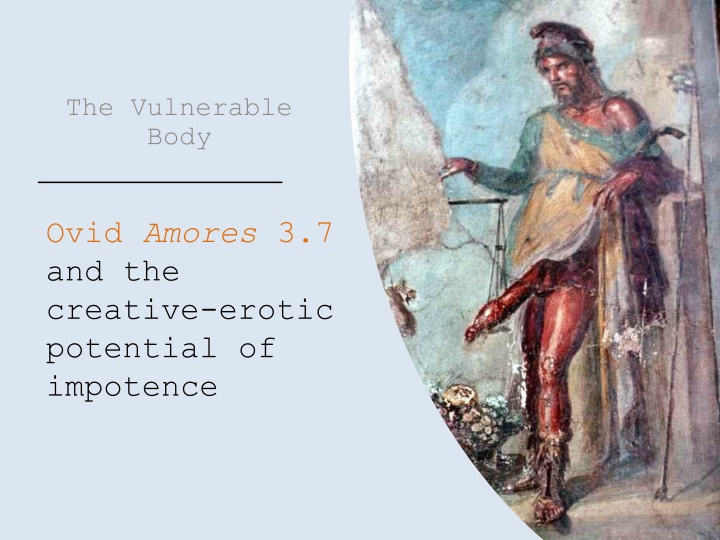
Exploring Ovid's Elegiac Collections Through Desire and Creative Erotic Potential
Delve into the depths of Ovid's Amores, analyzing the creative-erotic potential of impotence, the interplay of desire and perversion, and the impact of Augustan legislation on adultery. Discover the circular structure of the elegiac couplet, and the editorial nuances that mark the edges of Ovid's collections, emphasizing open-endedness and cultural renegotiation.
Download Presentation

Please find below an Image/Link to download the presentation.
The content on the website is provided AS IS for your information and personal use only. It may not be sold, licensed, or shared on other websites without obtaining consent from the author. If you encounter any issues during the download, it is possible that the publisher has removed the file from their server.
You are allowed to download the files provided on this website for personal or commercial use, subject to the condition that they are used lawfully. All files are the property of their respective owners.
The content on the website is provided AS IS for your information and personal use only. It may not be sold, licensed, or shared on other websites without obtaining consent from the author.
E N D
Presentation Transcript
The Vulnerable Body Ovid Amores 3.7 and the creative-erotic potential of impotence
Size matters? 3.1: 70 lines 3.2: 84 lines 3.3; 48 lines 3.4: 48 lines 3.5: 46 lines 3.6: 106 lines (central swell) 3.7: 84 lines (still big!) 3.8: 66 lines 3.9: 68 lines 3.10: 48 lines 3.11a: 32 lines 3.11b: 52 lines (84 in all) 3.12: 44 lines 3.13: 36 lines (flagging now) 3.14: 50 lines 3.15: 20 lines (burnt out) Amores book 1: 15 Amores book 2: 19 Amores book 3: 15
Amores 3.2 (and 3.15) end points and turning posts at the races
Desire is always perverse a) Am.3.4.17: nitimur in vetitum semper cupimusque negata ( we always strive for what is forbidden and covet what is denied us. ) b) Am.3.4.25-6: quiduid servatur cupimus magis, ipsaque furem / cura vocat. pauci quod sinit alter amat ( Whatever is guarded we desire all the more, and care itself invites the thief. ) c) 3.4.31: iuvat inconcessa voluptas ( Pleasure delights in the forbidden. ) d) Am.3.4.29: nec proba fit, quam vir servat, sed adultera cara ( She whom her husband guards is not made honest, but becomes instead a mistress much desired. )
Might Augustan legislation against adultery (leges Iuliae, 23BCE) motivate/cause adultery? Does the normative produce the subversive?
The circular structure of the elegiac couple(t) Hexameter pentameter Epic - elegiac Male - female Success - failure Expansion - limitation
The edges of Ovid s elegiac collections are marked by a method of structuring editorial meaning which emphasizes circularity, open- endedness, and renegotiating cultures of reading,
More amor, more mora Am.3.7.80: nec mora ( without delay ) Remedia Amoris, 83-4 For delay adds strength: delay ripens the tender grapes and makes what was once young shoots strong crops . Remedia 91-2 Oppose beginnings/at the beginning; treatment is applied too late when troubles have grown strong through long delays.
The toing and froing of desire Phyllis at Remedia 55-6, 591-608 55-6: Phyllis would have lived, had she used my counsels / and taken more often the path she took nine times. 599ff: There was narrow path, overcast by the long shadows, by which she often went down to the sea. For the ninth time she trod that unhappy path! Cf. Am.3.7.25-6: I remember Corinna requesting, and me supplying, nine times in one short night!






















